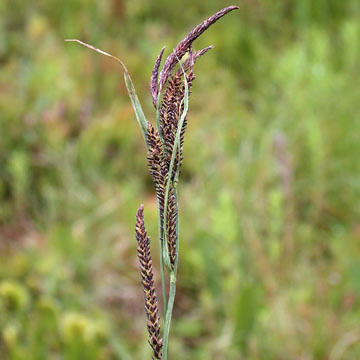

Carex emoryi - (image 1 of 6)
Taxonomy
Family: Cyperaceae
Section Phacocystis
Habitat
Streambanks, roadside ditches.
Associates
Distribution
NY to ND and Manitoba, south to VA, northern AR, and TX.
Morphology
Rhizomatous perennial; stems slender, arising laterally, scabrous on the angles, 40-120 cm; lowest leaves reduced to reddish brown, bladeless sheaths; main leaves 3.5-6(-8) mm wide; sheaths glabrous, reddish dorsally, tawny and generally convex at the apex; lowest bract leaf-like, about equaling the inflorescence, the other reduced; staminate spikes 1-3, usually 2, 1.5-5 cm; pistillate spikes 3-5, short-pedunculate or sessile, erect, 2-10 cm, slender, tapering at the base, the uppermost with some distal staminate flowers; pistillate scales with a broad green or tawny midstrip and a submarginal tawny to reddish-brown band, usually narrower and shorter than the perigynia; perigynia 1.7-3.2 mm, green to stramineous, not dotted, flattened and planoconvex, usually several-nerved on each side, short-beaked; achene lenticular.
Notes
Fruiting May to June.
Wetland indicator: OBL
Differs from many other members of this section is having a convex sheath apex and truncate ligule.
References
Gleason, Henry A. and A. Cronquist. 1991. Manual of Vascular Plants of
Northeastern United States and Adjacent Canada. Second Ed.
The New York Botanical Garden. Bronx, NY
|
© Michael Hough 2018 |